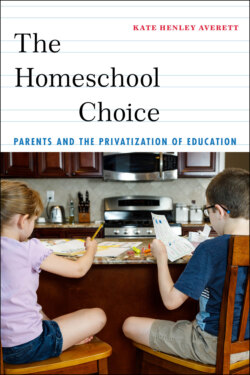Читать книгу The Homeschool Choice - Kate Henley Averett - Страница 24
Childhood Gender and Sexuality
ОглавлениеUnderstandings of childhood are historically and culturally situated; in fact, the very idea that there is a distinct phase of life that falls between infancy and adulthood is, historically speaking, relatively new.2 The emergence of the idea that childhood is marked by a special, even sacred quality is even newer. As sociologist Viviana Zelizer chronicled, compulsory education only emerged in the United States when the “productive child”—who was expected to contribute to the labor and upkeep of the household, through housework, caring for younger siblings, and/or paid labor—gave way to the “sacred child”—who was believed to be in need of protection from the adult world.3 As the ideology of the sacred child took hold, schools were seen as the ideal place for children to spend their days, both to protect them from participation in labor and to care for their developing minds. The concept of the sacred child has thus always been intimately linked to ideas about the role of education—and, in particular, public schools—in children’s lives. As the role and importance of public schools have been increasingly questioned in recent years, have our ideas about childhood also changed?
And what, exactly, is “sacred” about the sacred child? One key component of this ideology of childhood is the concept of childhood innocence—but children’s innocence has always been somewhat contested, and these debates often play out in the context of education. For example, behind debates about abstinence-only versus comprehensive sex education in schools is the question, do children need to be protected from knowledge about sexuality, or does keeping them from such knowledge harm children?4 Not only do changes in social beliefs about education warrant an examination of changes in understandings of childhood, then, but they also indicate a need to interrogate broader social anxieties about childhood gender and sexuality.
Theorists of childhood gender and sexuality emphasize the importance of the institutional context to how children experience and understand gender and sexuality.5 Two institutional contexts that are especially important in children’s worlds are the family and education. The family is generally the first context in which children learn about gender and sexuality, both through explicit talk about these concepts and through the implicit lessons that come from taking part in gendered family life.6 Schools, too, are spaces where children both receive implicit and explicit messages about gender and sexuality and also “play” with gender in their interactions with other children.7 Parents perceive the environment of schools to be highly gendered, and their concerns about peer influence at school tend to be formulated in racialized, classed, gendered, and sexualized terms: that is, parents construct racial, class, and gendered “others” as potentially dangerous influences on their own (assumed-to-be) innocent, impressionable children.8 Because parental concern about the school environment is a common reason parents cite for opting to homeschool, we would thus expect gender and sexuality to factor into their narratives about this decision.
In this chapter, I look at the ways in which gender and sexuality appear in the narratives of homeschooling parents in order to expand our current theoretical and empirical understandings of gender and sexuality in the context of both education and the family. Looking at a case in which the lines between these institutions are blurred opens a space for novel conceptualizations of gender and sexuality in childhood. I ask, in what ways are parents’ concerns about school environment and academic instruction grounded in their conceptions of gender and sexuality? How do homeschooling parents resist—or reproduce—popular notions of gendered childhoods?
